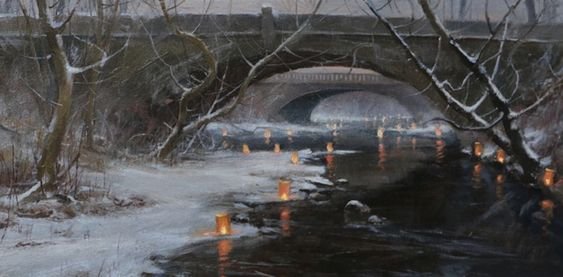Creating Mood and Poetry in Your Work
Kenn Backhaus likes to explain to his students that there are certain doors that we need to continually open and make sure we understand as artists—draftsmanship, value, color harmony, line, rhythm, movement, texture, and brushwork. These are all doors that we probably open up often. If we are not opening them often, we need to open those doors and ensure we are looking to keep all those principles and foundations to a very high degree.
But this specific element we are discussing can be questioned like this: “What can I bring to the party?” In other terms, an artist needs to have the mindset of “how can I make my paintings different than I’ve done in the past, or different than somebody else?” or “what can I bring to the party that is different from what others are bringing?” It is not always a competition with other artists, but you want to make sure that your paintings resonate with the viewer in a unique way. This happens when you start to think of making the scene that everyone is painting stand out. Kenn explains that mood and poetry are both key when trying to separate yourself.
We can all write a paragraph about a subject that we love. But, if you had a poet write one, he or she would use certain words and terminologies that would make us see the scene and admire a beautiful depiction in a different way. Poets set the mood for the reader or listener. And a visual, like a painting, can be the same way. We can sometimes look at our paintings and realize something needs to change, or we need to do something more to it. Kenn takes his shots from days or years before and tries them from different vantage points. He starts to look at that same idea from this vantage point, from maybe a lower vantage point, maybe up higher, maybe around the corner a little bit, maybe—instead of front lit, go to the whole backside of it, and now he is looking at it with a different light effect upon it. Now it’s backlit or side lit. For example, if you have a backlit scene, you now have this light mood, which made all the other subjects very subtle, moody, and almost mysterious. It would not be as obvious as a front lit scene. Or, you go out on a day when it’s very foggy, and everything’s very ethereal, you kind of just make out things. And then the next day you wake up, and everything is just blatant in your face. And that’s what poetry can be; not everything is obvious in one go.
Instead of a value scale where Kenn has some bright lights and medium values or dark colors, he will go to a high-key painting, middle-key painting, or low-key painting and set up a value range that is very different. That alone can really create a very different look. Or, Kenn suggests limiting yourself to a different palette. For example, many have been introduced to the Zorn palette. The Zorn palette refers to a palette of colors attributed to the Swedish artist Anders Zorn. Zorn had several different palettes, but one of them he used had yellow ochre, ivory black, vermilion, and lead white. And with those four colors, he came up with a variety of different shades and secondary colors and so forth. And, sometimes, having a more limited palette than the one we normally paint with can produce something very different. Painting with a good shape, good value, and good composition but with a limited palette can sometimes create a more interesting mood. It is simple but effective.
To learn from Kenn Backhaus, we recommend his video download package:
To listen to Kenn and Gabor’s full podcast episode on Creating Mood and Poetry, click here


